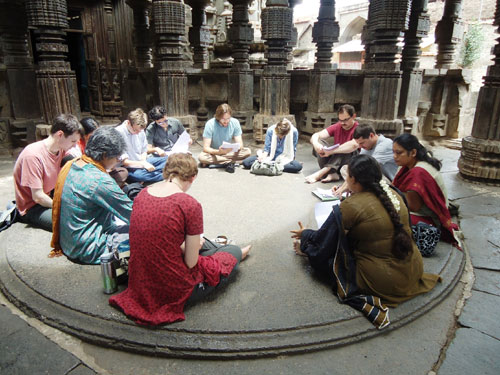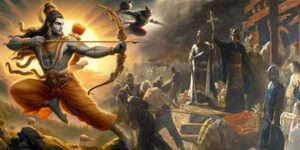Sanskrit is often referred to as the language of the Devas. But is this really true? Certainly the antiquity of Sanskrit is not in question, as there is little doubt that the vibrational and sound model for Sanskrit is considerably old, as Sanskrit as a language is traced back to at least the Brahmi script[i], and some Indologist have theorized that Brahmi was a later variant of the Indus Valley script, but these are hotly debated issues among those that study the ancient history of India.
Some refer to Sanskrit as devavani, which can be literally translated as the ‘speech of the Gods’, ‘divine speech’ or divine language’. If one allows their mind to drift back into human history or within the limited scope of recorded history, relative to language, a common theme is revealed, namely the concept of a Divine language, as this concept did appear in a variety of the world’s ancient traditions.
Often the concept of a divine language is dismissed as an attempt to control the masses or extol a religious caste; yet, one must wonder could there be more to this idea of a divine language?
Few subjects I have written about elicit more arguments than the suggestion that Sanskrit is a Divine Language. Yet, it was Joseph Campbell who recognized the spiritual importance of Sanskrit when he stated, ‘Now I came to this idea of bliss because in Sanskrit, which is the great spiritual language of the world…’ (‘The Power of Myth’ p. 120). While Campbell did stop short of proclaiming Sanskrit as a divine language, it is implied to a degree with the proclamation of ‘…the great spiritual language of the world…’ Yet, aside from the concept of a Divine language, there is a great resistance among modern spiritual seekers to recognize the spiritual significance or important spiritual role of Sanskrit.
Often this is rooted in a misplaced belief in evolution of language instead of devolution of language. To understand this evolution/devolution conflict and spiritual significance of Sanskrit, one must delve deeper into the meaning of Devavani.
Modern Vs. Ancient Language.
While modern language is a dynamic language, meaning a language that is adding additional to its vocabulary as new technology and slang terms arise that fulfils an important role in meeting the mundane needs of life and communication. Interestingly, the world has been slowly creeping toward a global standard of English as a common standard.
Ironically, American English is one of the youngest languages in the world; which raises the question, ‘Is modern English really a clear path to the Devas?’ and ‘Is it superior in its clear encapsulation and communication of spiritual/dharmic concepts?’
From the traditional view of Yoga/Hinduism, the Devas speak in a language of light (jyothi). Humanity speaks in the various languages that have manifested globally, culturally and over time.
From the view of Yoga/Hinduism, spirituality requires a bridge between the languages of light and the languages of humanity.
Hence, the important function of a divine language—bridging the language of humanity and the language of light.
Within the world’s copious manifestations of language, one of the last remaining bridges between the language of light and the language of humanity is Sanskrit.
As Sanskrit is a language based upon vibration and frequency. As Sanskrit bridges the language of light and particle, traditionally the view is that Sanskrit naturally brings the language light into form, and allows form to be expressed and directed back into light.
From the position of the Sanskrit grammarian, the language of light and words need two powers, the power of being perceived, and the power of causing perception (vakyapadiya 55). Sanskrit is a language that fulfills this bridge between light and humanity. Additionally, it was the emanation of light expressed in the primal syllable (AUM) which is the vibrational substratum of all of creation (tattvas). This substratum is generated through the Sanskrit letters and forms the Sanskrit alphabet.
The combination of sounds from the Sanskrit alphabet merge together to form vibrational essence, eventually expressed as words. This process is akin to a modern chemistry or molecular biology class, in which the base components are mixed to form more complex components.
This relationship allows one to effect change on a molecular and subatomic level through the intermediary of the language of light—Sanskrit.
Views Regarding Empowered Sanskrit.
There are several views toward the application of the divine language. Yet for our purposes, these can often be reduced to two primary positions in the modern age: 1) Sanskrit has its own innate power (shakti). 2) The Sanskrit word must be empowered by a Guru. As emanating from the primal sound and forming the elements (tattvas) of creation, there is little doubt that the commonly known proto sounds of Sanskrit do carry a shakti within their own vibratory matrix.
Likewise, it would be true that the Guru would add a shakti to a mantra when it is given to a disciple (sishya). Therefore, it would be correct to take the position that both are correct relative to the level of consciousness of the spiritual aspirant.
In other words, one that has developed the level of consciousness necessary can easily tap into the shakti of the language with only assistance of the vibratory essence of the Sanskrit letters. For those that lack awareness of the more subtle levels of vibration, the shakti of the Guru can in essence ‘jump start’ their system, and aid in their spiritual understanding and transformation.
Understanding Levels of Speech.
Through the process of application of the bridge between the language of the Devas and humanity, an individual comes closer to experience the sphota[ii] or expansiveness of the word. In its higher manifestation sphota is the primal vibratory expansiveness of sound[iii], within some traditions this is referred to as Shabda Brahman or the sound qualities of Brahman.
In its lower manifestation and from a grammar perspective, it is grammar. Philosophically there are four levels of speech, with the latter three being the greater focus of grammar:
- Para—unmanifested knowledge
- Paśyantī—conceptualization, cognition
- Madhyamā-speaking
- Vaikarī–comprehension[iv]
It is through the four levels of speech one can see a developed system for cognition ranging from a lower manifestation of Paśyantī as individual cognition to a type of Para Paśyantī that bridges the cosmic unmanfested knowledge and cognition; it is this para Paśyantī that is responsible for the flash of realization and understanding that can suddenly occur.
This can be achieved through repetition (japa) of mantra, and is often experienced through a sudden burst of realization or direct experience of light.
This is an exciting level for examination and is at the heart of modern seekers of the spiritual experience. Likewise, it is often one of the most abused areas, as it rather easy for the ego to proclaim various realizations that may be false.
Hence, one can easily see the importance of having a teacher and developed skills of discernment (vivek) within the practice of not only Yoga/Hinduism, but within the application of mantra as well.
While we are only ‘scratching the surface’ of Devavanni, one can easily see the important role of a Divine language, as well as its fundamental necessity to bridge the language of light and the language of humanity.
Critics will argue that many have spiritual experiences, and they have no knowledge of a Divine language. Certainly it is correct that human history is filled with examples of spontaneous awakening of knowledge, one of the common threads among those that have had such experiences is they lack a nomenclature to encapsulate the spiritual experience; giving birth to variety of vague and difficult to understand terms that vary in substance and clarity.
Often, due to the lack of a nomenclature they are hindered in helping others obtain the same results. Likewise, it is difficult or impossible for them to return to that state at will, or ever in some cases. Therefore, the experience is more akin to a karmic moment than a mastery of a state of consciousness.
An understanding of and application of a Divine language nicely fulfills this need, which would explain why India has produced enlightened teachers at a prolific rate and to a greater degree than any other known cultural outside of the dharmic traditions.
By Yogi Baba Prem
Th. D. (religious), Yogacharya, Veda Visharada
More @ www.vedicpath.com
[i] Brahmi Script is dated by academics to circa 4 BCE. https://en.wikipedia.org/wiki/Brahmi_script
[ii] Sphota is an ancient term meaning ‘burst forth’, a great focus is placed upon it by Bhartṛhari. This focus is more toward grammar and is of great importance to Vyakarana (grammar) traditions. Vyakarana is a vedanga or limb of the Vedas. One of the famous commentators is Bhartṛhari, who is dated by academics to circa 5 CE.
[iii] In this section I am suggesting that sphota has a para aspect as opposed to just the latter three levels of speech
[iv] Bhartṛhari focused heavily upon Paśyanti, Madhyamā and Vaikarī






























